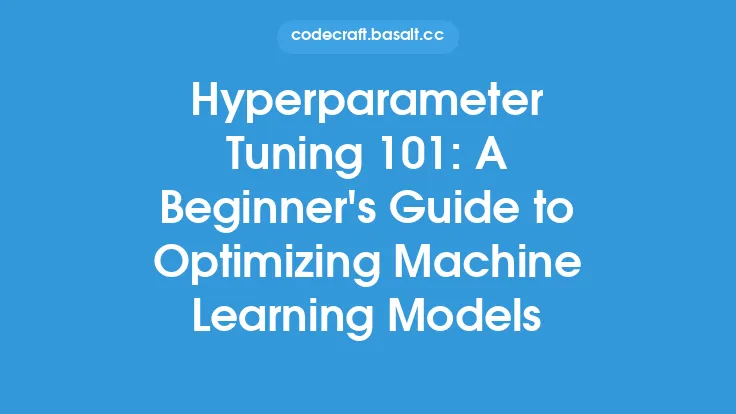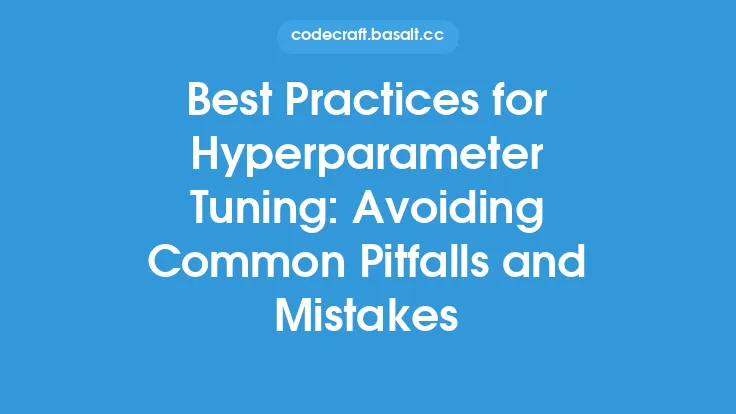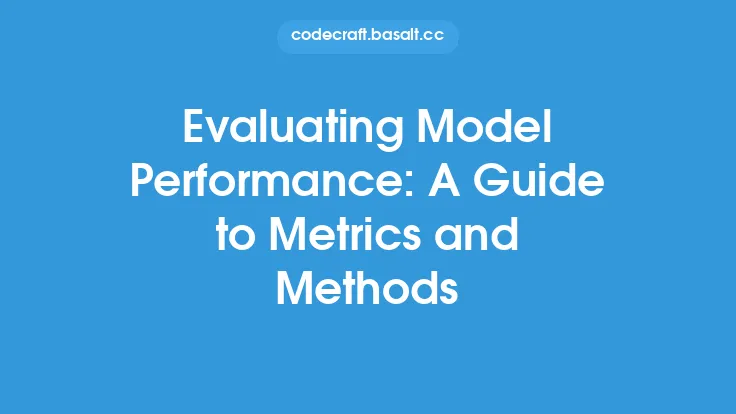When it comes to machine learning, hyperparameter tuning is a crucial step in improving the performance of a model. Hyperparameters are the parameters that are set before training a model, and they can have a significant impact on the model's performance. In this article, we will take a step-by-step approach to hyperparameter tuning, exploring the different techniques and strategies that can be used to optimize model performance.
Introduction to Hyperparameter Tuning
Hyperparameter tuning is the process of selecting the best combination of hyperparameters for a machine learning model. This can be a time-consuming and challenging task, as there are often many hyperparameters to tune, and the optimal combination can depend on the specific problem and dataset. However, with the right approach, hyperparameter tuning can significantly improve the performance of a model. There are several types of hyperparameters that can be tuned, including learning rate, regularization strength, and the number of hidden layers in a neural network.
Preparing for Hyperparameter Tuning
Before starting the hyperparameter tuning process, it's essential to prepare the data and the model. This includes preprocessing the data, splitting it into training and validation sets, and defining the model architecture. The data should be preprocessed to ensure that it's in a suitable format for the model, and the training and validation sets should be split to evaluate the model's performance. The model architecture should be defined, including the type of model, the number of layers, and the activation functions.
Hyperparameter Tuning Techniques
There are several hyperparameter tuning techniques that can be used, including grid search, random search, and Bayesian optimization. Grid search involves searching through a predefined grid of hyperparameters, while random search involves randomly sampling the hyperparameter space. Bayesian optimization uses a probabilistic approach to search for the optimal hyperparameters. Each technique has its strengths and weaknesses, and the choice of technique will depend on the specific problem and dataset.
Grid Search
Grid search is a simple and intuitive hyperparameter tuning technique. It involves defining a grid of hyperparameters and evaluating the model's performance at each point on the grid. The grid can be defined using a range of values for each hyperparameter, and the model's performance can be evaluated using a metric such as accuracy or mean squared error. Grid search can be computationally expensive, especially for large grids, but it can be effective for small to medium-sized problems.
Random Search
Random search is another popular hyperparameter tuning technique. It involves randomly sampling the hyperparameter space and evaluating the model's performance at each sample point. Random search can be more efficient than grid search, especially for large hyperparameter spaces, as it avoids the need to evaluate the model at every point on the grid. However, it can be less effective than grid search, as it may not find the optimal combination of hyperparameters.
Bayesian Optimization
Bayesian optimization is a more advanced hyperparameter tuning technique. It uses a probabilistic approach to search for the optimal hyperparameters, based on the model's performance at previous sample points. Bayesian optimization can be more efficient than grid search and random search, as it uses the model's performance to guide the search. However, it can be more complex to implement, and it requires a good understanding of the underlying mathematics.
Evaluating Hyperparameter Tuning Methods
Evaluating the effectiveness of hyperparameter tuning methods is crucial to ensure that the optimal combination of hyperparameters is found. This can be done using a variety of metrics, including accuracy, mean squared error, and F1 score. The model's performance should be evaluated on a validation set, to ensure that the hyperparameters are generalizing well to unseen data. The evaluation metric should be chosen based on the specific problem and dataset, and it should be used to compare the performance of different hyperparameter combinations.
Implementing Hyperparameter Tuning in Practice
Implementing hyperparameter tuning in practice can be challenging, especially for large and complex models. However, there are several tools and techniques that can be used to make the process easier. These include hyperparameter tuning libraries, such as Hyperopt and Optuna, and cloud-based platforms, such as Google Cloud AI Platform and Amazon SageMaker. These tools and platforms provide a range of features, including automated hyperparameter tuning, distributed training, and model deployment.
Common Challenges and Pitfalls
There are several common challenges and pitfalls that can occur during the hyperparameter tuning process. These include overfitting, underfitting, and the curse of dimensionality. Overfitting occurs when the model is too complex and fits the training data too closely, while underfitting occurs when the model is too simple and fails to capture the underlying patterns in the data. The curse of dimensionality occurs when the number of hyperparameters is too large, making it difficult to find the optimal combination. These challenges and pitfalls can be avoided by using techniques such as regularization, early stopping, and dimensionality reduction.
Conclusion and Future Directions
In conclusion, hyperparameter tuning is a crucial step in improving the performance of a machine learning model. By using the right techniques and strategies, it's possible to find the optimal combination of hyperparameters and achieve state-of-the-art results. However, hyperparameter tuning can be a time-consuming and challenging task, especially for large and complex models. Future research directions include the development of more efficient and effective hyperparameter tuning techniques, such as automated hyperparameter tuning and multi-objective optimization. Additionally, the use of hyperparameter tuning in real-world applications, such as computer vision and natural language processing, is an area of ongoing research and development.





